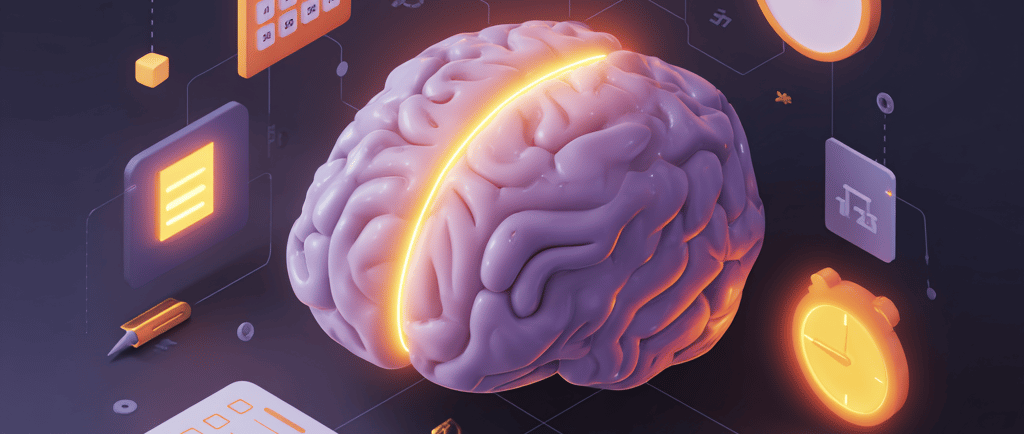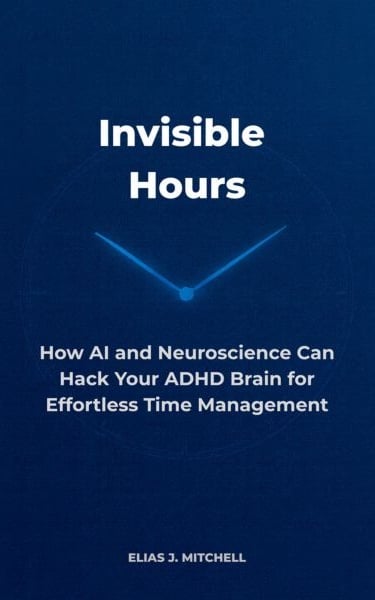ADHD Prefrontal Cortex: Why You Need Different Tools
Feel like your brain's CEO is always offline? Learn about the ADHD prefrontal cortex and discover the executive function tools designed for your unique wiring.
Elias J. Mitchell
10/2/20256 min read


Your Prefrontal Cortex Isn't Broken—It Just Needs Different Tools
You’re staring at a task. It’s not even a hard task. Maybe it’s an email, a phone call, or that pile of laundry that has achieved sentience in the corner of your room.
You know exactly what you need to do. You have a clear, step-by-step plan in your head. You want to do it. You can almost feel the sweet relief of having it done. And yet… you can’t move. An invisible wall stands between your intention and your action.
So the internal monologue begins. “Why can’t I just do the thing? What is wrong with me? Everyone else can handle this. I’m just lazy.”
If that voice sounds familiar, I need you to hear this loud and clear: You are not lazy, and your brain is not broken. You’ve just been handed the wrong user manual. For years, I’ve worked with brilliant, creative people who felt fundamentally flawed because of this exact struggle. The truth is, they weren’t fighting a character defect; they were fighting their own brain’s unique wiring without the right equipment.
The part of your brain at the center of this struggle is the prefrontal cortex. And understanding it is the first step to finally putting down the weapons and starting to work with yourself instead of against yourself.
Meet Your Brain’s CEO: A Quick Tour of the Prefrontal Cortex
Imagine your brain is a massive, bustling company. The prefrontal cortex (PFC), located right behind your forehead, is the Chief Executive Officer. It’s the corner office, the command center, the place where all the big-picture decisions are made.
The PFC is in charge of a set of high-level mental skills known collectively as executive functions. These aren’t just buzzwords; they are the skills that allow you to “execute” tasks and navigate life. They include:
Planning and Prioritizing: Deciding what’s important and in what order to do it.
Task Initiation: The ability to actually start the thing you planned to do.
Working Memory: Holding information in your mind while you use it (like remembering a phone number while you dial it).
Emotional Regulation: Managing your feelings so they don’t derail you.
Focus and Attention: Directing your mental spotlight and keeping it there.
When your PFC is running smoothly, you feel like you’re in the driver’s seat of your life. But for those of us with ADHD brains, it can often feel like the CEO is on an extended lunch break, and the interns are trying to run the company.
The ADHD Brain Difference: Not Damaged, Just Different Wiring
For a long time, the conversation around ADHD has been centered on deficits and disorders. But modern neuroscience gives us a more accurate and compassionate picture. The ADHD prefrontal cortex isn’t “damaged” or “less than” a neurotypical one—it operates under a different set of rules.
Power Fluctuations and Neurotransmitter Gaps
Think of your PFC as a high-performance engine. A neurotypical brain might run on a steady, reliable stream of fuel (neurotransmitters like dopamine and norepinephrine). The ADHD brain, however, often has a less consistent fuel delivery system. It’s not that the fuel isn’t there, but the way it’s transmitted and received can be inefficient.
This means that on some days, or for some tasks (usually the new, interesting, or urgent ones), the engine roars to life with incredible power—hello, hyperfocus! But for other tasks (the boring, routine, or overwhelming ones), the engine sputters and stalls. There simply isn’t enough neurochemical “juice” to get the gears of executive function turning.
Why "Trying Harder" Is Like Running Windows on a Mac
This is why the most common advice—“just try harder,” “be more disciplined,” “use a planner”—so often fails. It’s like someone handing you a piece of Windows software and telling you to run it on your MacBook. You can click the icon as hard as you want, but it’s fundamentally incompatible with the operating system.
When you try to force your ADHD brain to use neurotypical strategies, you’re creating a massive amount of internal friction and shame. You’re asking your brain’s CEO to do its job without a reliable power supply or the right software. It was never going to work, and it was never your fault.
Stop Fighting Your Brain: The Power of Neurodivergent Tools
So, if you can't force it, what’s the solution? You change the tools.
You wouldn’t blame a brilliant artist for not being able to paint a masterpiece with a broken brush. You’d get them a better brush. This is the entire philosophy behind building an effective life with an ADHD brain. We need to stop focusing on fixing the artist and start focusing on building them a better toolkit. These are what we can call neurodivergent tools—strategies, systems, and supports designed specifically for our brain’s operating system.
Moving from Internal Willpower to External Scaffolding
The core principle is simple: if a function is weak or unreliable on the inside, we must build a strong, reliable support for it on the outside. We stop relying on our shaky internal willpower and start building a sturdy external scaffold.
If your working memory is like a small handful of sticky notes, you don’t just try to remember more; you build an external system with Trello or a physical whiteboard that can hold unlimited sticky notes for you. If your sense of time is foggy, you don’t just try to “be more aware”; you use a visual timer that makes time a concrete, physical thing you can see.
What "Different Tools" Actually Look Like
These tools aren’t complicated. In fact, the best ones are incredibly simple. They are less about adding complexity and more about reducing cognitive load. A “different tool” might be:
Using color-coded calendars to see your day visually instead of as a list of words.
Implementing body doubling—working silently with another person—to create gentle accountability that helps you start a task.
Using automation to handle routine tasks that drain your executive function battery.
Breaking a task down into absurdly small physical steps to overcome the paralysis of the “Wall of Awful.”
This is the work I explore in my book, Invisible Hours: How AI and Neuroscience Can Hack Your ADHD Brain for Effortless Time Management. It’s about becoming a compassionate engineer for your own mind, learning to identify the points of friction and building elegant, simple systems to smooth the path forward.
Building Your Personalized Executive Function Toolkit
Your brain is a powerful engine that was simply given the wrong user manual. The journey forward isn’t about a personality transplant; it’s about a strategy transplant. It’s about embracing ADHD cognitive support that honors your wiring.
It starts with giving yourself grace and getting curious. It starts with acknowledging that the CEO in your brain isn’t lazy—it’s just overworked and under-supported. Your job is to become its most valuable and trusted executive assistant, providing it with the exact tools, systems, and environment it needs to do its best work.




Tired of Feeling Like Your Brain's CEO Is on Permanent Vacation?
The problem isn't a lack of willpower; it's using the wrong tools for the job. You can’t organize a chaotic company without a clear system, and you can’t navigate life with an ADHD brain without a personalized toolkit.
In my book, Invisible Hours: How AI and Neuroscience Can Hack Your ADHD Brain for Effortless Time Management, we stop the cycle of shame and start building your custom executive function toolkit from the ground up, one practical and compassionate step at a time.
Elias J. Mitchell writes about time management, productivity, and mindset, blending practical strategies with the smart use of AI to help readers work smarter and live better.




